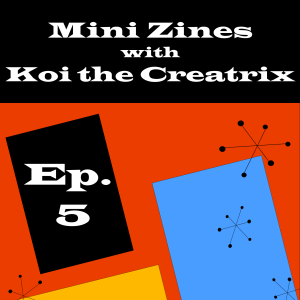
In this episode I collaborate with artist Koi The Creatrix to make mini zines. The challenges we faced included our zines going missing in the mail for extended periods of time.
Links
@koithecreatrix on Instagram
Koi’s monthly Postcard Club
@katcurio on instagram
@brattyxbre on youtube
@brattyxbre: Your Zine Sucks (And That's Okay)
Hedy Lamarr biography
Emilie Wapnick’s TED Talk on multipotentiality
When Things Fall Apart by Pema Chödrön
Some of these links are affiliate links and I may earn a small commission from them.
Mini Zine: "Who Am I?"
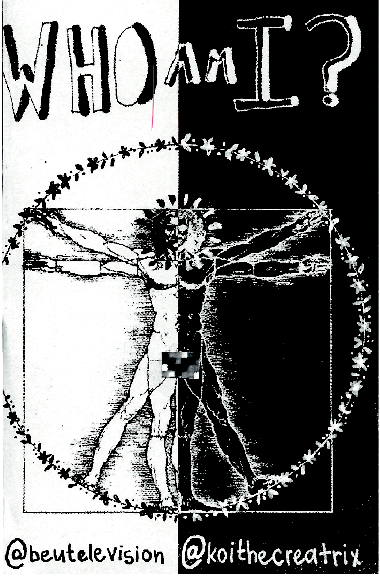
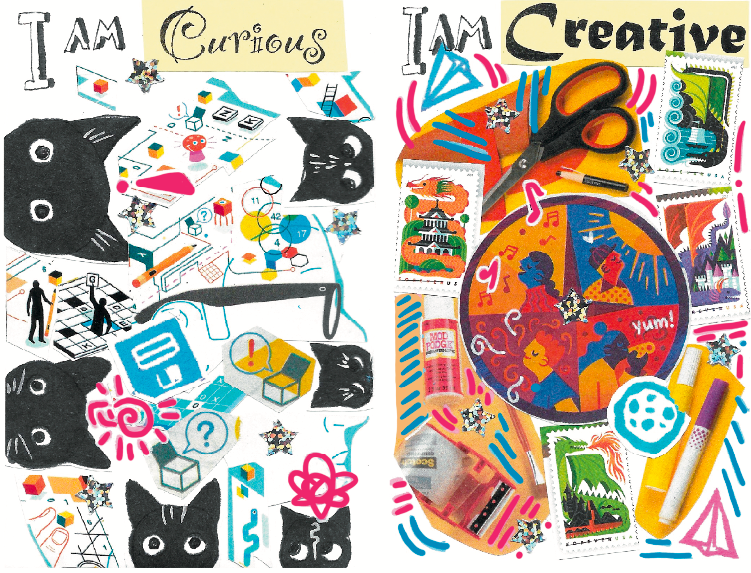
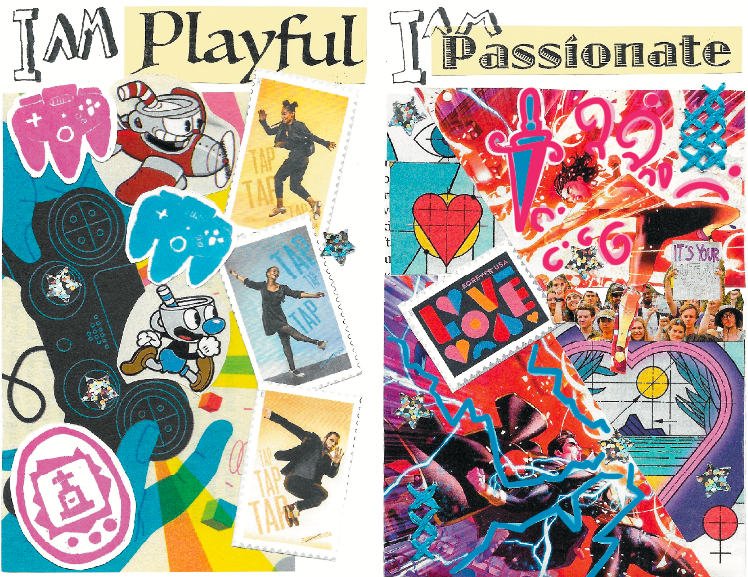
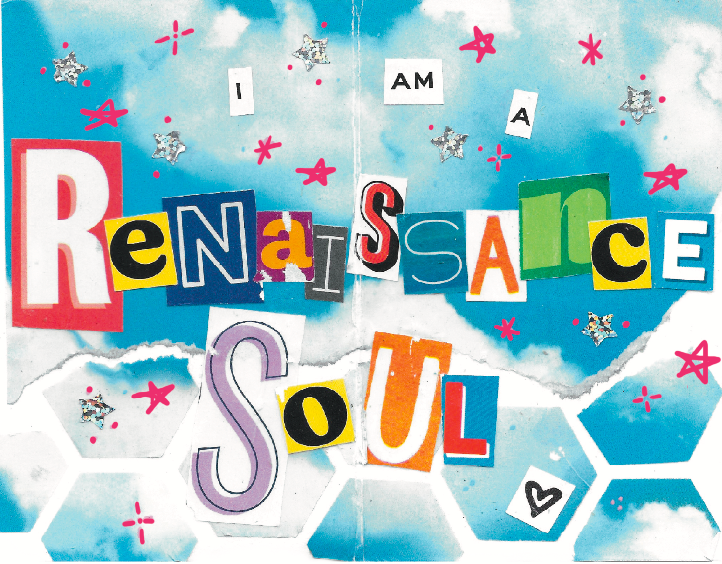
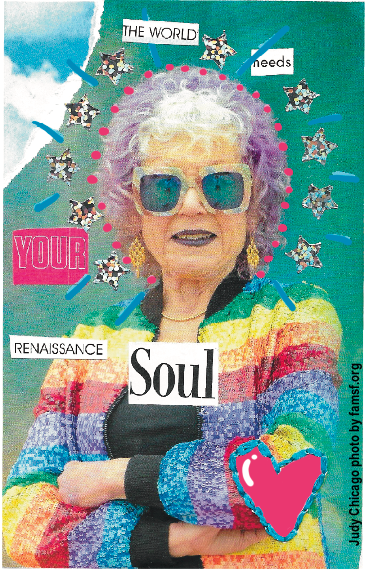
Mini Zine: Ren Soul
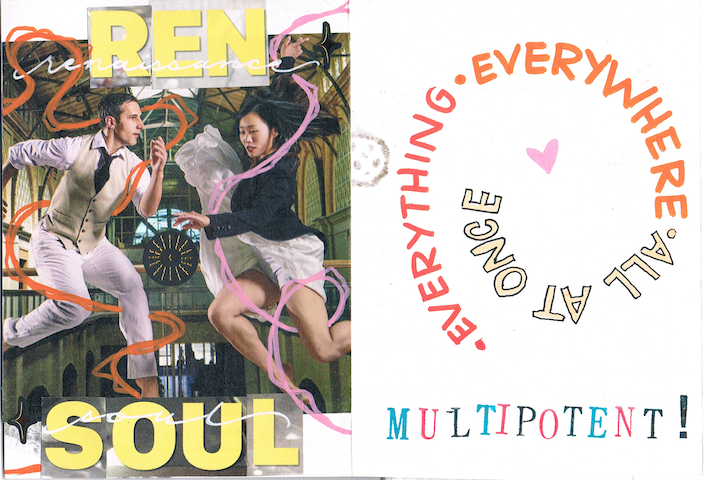
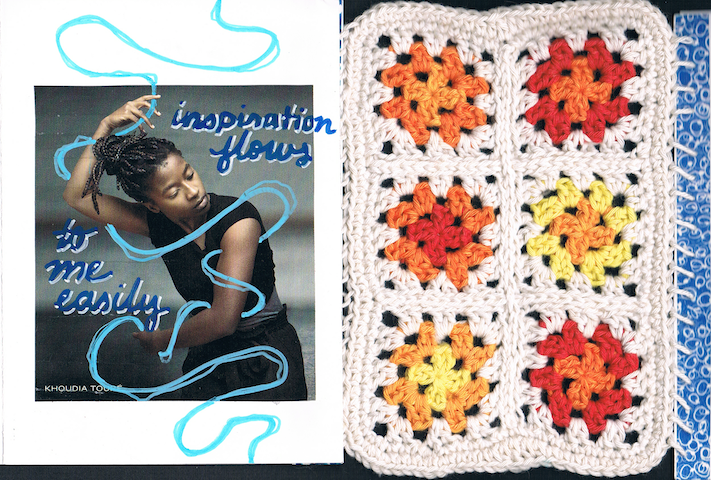
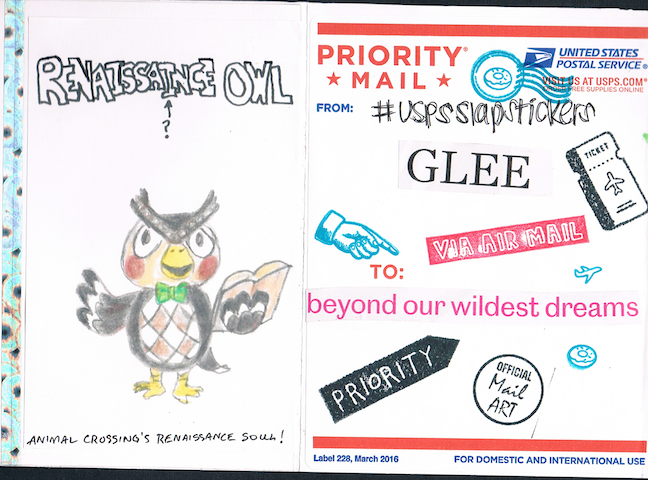
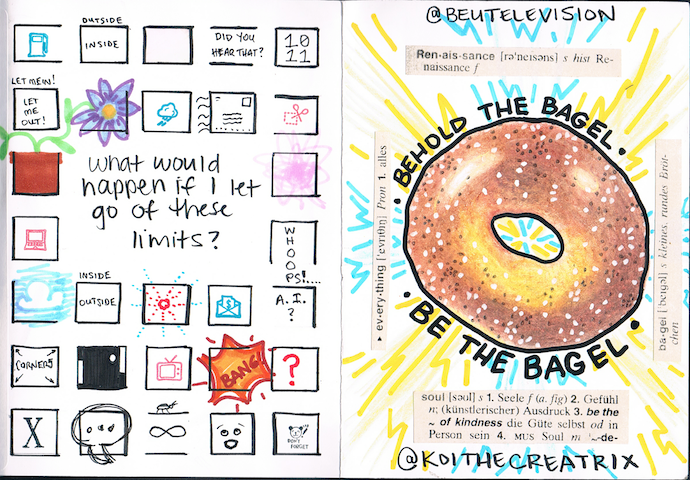
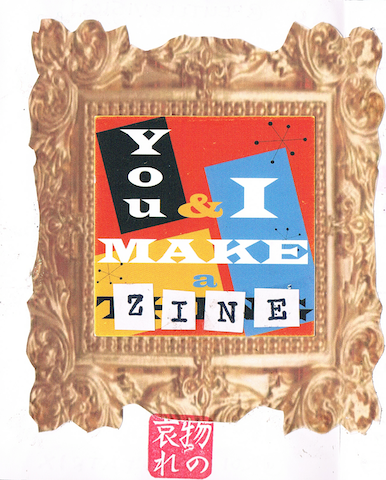
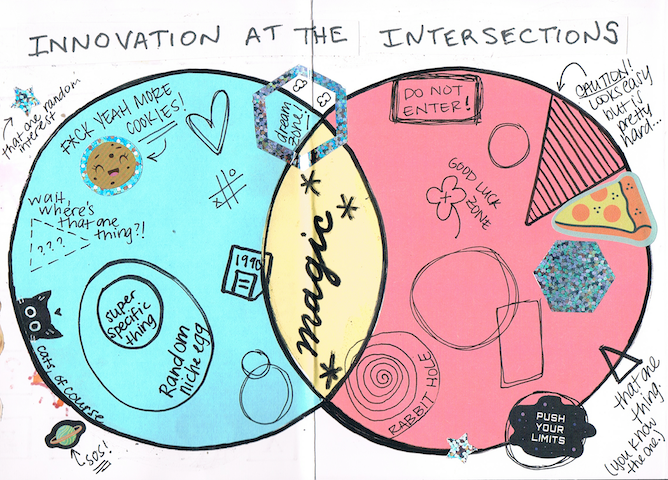
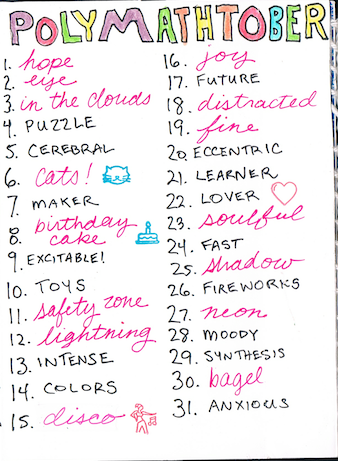
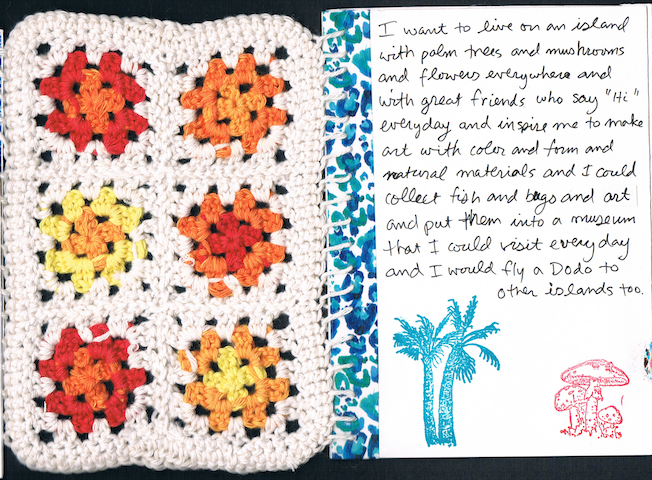
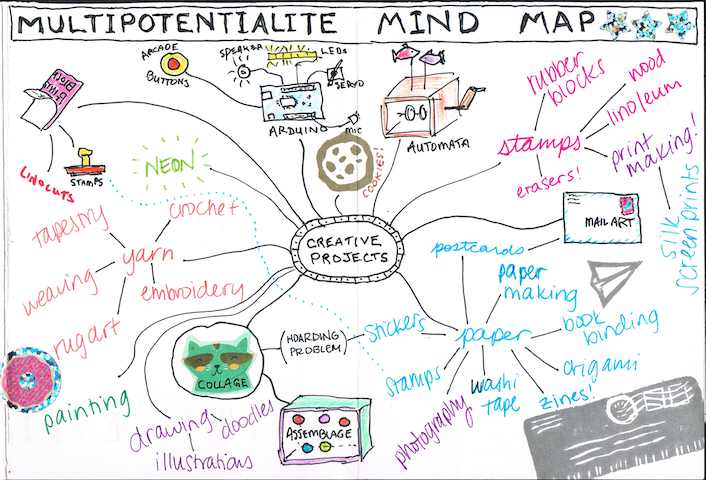
Transcript
Thomas: My guest today is Koi the Creatrix. Koi is a mixed media artist who identifies as Japanese American and Queer. In her art, Koi engages in sociopolitical discourse. She enjoys using bright colors and bold patterns, invoking pop art vibes. Her exploration of emotional themes, coupled with her seemingly chaotic displays, offer a deeply personal feel. And her Instagram handle is @koithecreatrix. Welcome to the podcast, Koi.
Koi: Hi, thank you so much for having me, Thomas.
Thomas: Before we get started, I wanted to ask you, you just finished a solo exhibition. It was at the Taube Museum of Art in Minot, North Dakota, is that right?
Koi: The Taube Museum, yeah.
Thomas: The Taube Museum, thank you. Tell me how that went and also how you felt about it.
Koi: You know, it was absolutely nerve wracking leading up to it as I think all events that I participate in tend to be, a lot of nerves and getting everything prepared and making it a cohesive collection. One challenge I face as a mixed media artist is that pieces may not have like a single theme or even a single medium throughout all of the art.
And so it was a challenge to keep some commonality between all of the work. But it went over really well. I heard from the museum director that they received a ton of positive feedback, and the Taube Museum, I have to say, is like my artistic home base. This is the first space that I felt an artistic community and support for my work, and really for the first time, saw myself considered as an artist to someone outside of my family, you know.
Thomas: Oh, that's wonderful. Isn't that a wonderful feeling when that happens?
Koi: It was fantastic. And so I have very deep ties to the folks there.
Thomas: I want to follow up on that. Did you have trouble saying the A word? Meaning artist?
Koi: Oh yeah, yeah, absolutely! Oftentimes I don't consider myself an artist, more of a creative. And I really resonate with… I'm racking my brain trying to remember the term, the people who are really into a lot of different activities. I know you identify closely with it as well.
Thomas: Multipotentialite.
Koi: Yeah.
Thomas: Yeah.
Koi: I think as a multipotentialite, I can enjoy many different activities and there's never really a sense of sticking with anything for too long or developing what I would consider, perhaps incorrectly, as expertise.
And so there is definitely that imposter syndrome leading up to it. And even now, even after the show I'm like, “Was it good? Were they just saying that?”
Thomas: Yeah, another term that I like to use for multipotentialite is Renaissance Soul. And it actually was considered a good thing in the Renaissance to have many different interests and try many different things. So in some ways, this idea of niching down or specializing is more of a recent phenomenon in our culture.
So I've come to the conclusion that, at least for me, there's nothing wrong with dabbling here and tinkering there and trying this new and trying that new. And in fact, part of the reason that I'm doing this podcast You And With Make A Thing is for that exact reason, I like to try new things.
I like to do something that I've never done before because it feeds our curiosity and it feeds learning and it just feels wonderful.
Koi: It really does. I love learning new things. At times get frustrated with it. Absolutely, but it is so enjoyable. I tend to not like doing the same thing over and over and really do like some sort of variety.
Thomas: Well, I think that's a great segue into jumping right into what we want to do. And I know that I had asked you to come up with three things that you might like to do, and I've also come up with three things.
And, I was thinking we could do it one of two ways. We could either bounce back and forth, you say a thing, I say a thing.
Or, we could just say the three things, you know, you could say your three things, I could say my three things, and then have a discussion. Do you have a preference?
Koi: I think I like the back and forth.
Thomas: Let's do the back and forth.
Koi: Yeah. Yeah.
Thomas: Do you want to start or do you want me to start?
Koi: I am happy to go first.
Thomas: Okay. Yeah, what do you have?
Koi: So the first thing I came up with was a mini zine. And actually this idea comes from another artist who I've been seeing on Instagram. She's been sharing all of these how-to's about her zine making process,
Thomas: Oh.
Koi: It's been something I've wanted to do. And then every time I look at it, it looks so blank. I don't know where to start. And I had the idea that in the spirit of collaboration and in this show, we could possibly work on it together in a way that we could mail it back and forth via snail mail, possibly.
Thomas: Yeah. I like that.
Koi: Yeah and incorporate that as part of the art. I tend to like handwritten letters and postcards and I thought it could be really a cool way to create together from so far away.
Thomas: I think that's a fabulous idea. I like that.
Koi: Yeah.
Thomas: I have not done my own zines. It's actually been on my list. Now I have participated in, I've contributed to zines, but those were always like single articles or a picture or something like that. But actually creating a zine, I like that idea, that's fantastic.
Koi: Yeah, yeah, it's one of those things that it looks simple in theory and creating it is not too hard at all. I just find all the white space very intimidating. I'm not sure where to go next.
Thomas: Yeah, well I hear you on that.
Koi: Yeah.
Thomas: Alright, that's a great idea. Alright, let's go on to one of mine. I've always been fascinated by Rube Goldberg machines. You know, these things where you put dominoes and marbles do this, and then this flips, and that starts. And I was thinking about the collages you do, and it occurred to me that this is sort of like a collage in motion,
Koi: Yeah.
Thomas: And I've never done one before. I don't know, so the thing that I haven't come up with yet is like how this could be collaborative. You know, maybe we could prompt each other, we could say, find this item and incorporate it in the Rube Goldberg machine or something like that. So maybe that's how we could do it. But, anyway, that's sort of one of the things that was on my mind.
Koi: That is so cool. I've seen all sorts of videos of those kinds of machines. They look so intricate and the idea kind of excites me hearing about it. I'm like, it sounds almost impossible on this end, especially having a pretty nosy cat who will be bound to knock things
Thomas: Oh,
Koi: Such a cool idea.
Thomas: Alright. I'm curious have you watched PythagoraSwitch?
Koi: No, I haven't. Where is it available?
Thomas: NHK. It's on NHK.
Koi: I’m not familiar. You said put dagger?
Thomas: PythagoraSwitch. It's their name for Rube Goldberg machine, actually. They have this little thing called PythagoraSwitch Mini, which is like a five minute show. And they always introduce a show with a Rube Goldberg machine, and then they end the show with one.
Koi: Oh, very cool. Yeah. I'm so glad that you mentioned this because I guess for context, my dad's side of the family is from Japan. I had lost contact with them for a significant amount of my life. And so much of the Japanese elements in my art is like re-exploring that. And so this sounds like such a cool thing. It's totally a rabbit hole. I'm going to get lost now.
Thomas: Okay. Yeah. If you have a chance to go to YouTube and look up PythagoraSwitch.
Koi: Oh yeah. I already have a browser pulled up.
Thomas: Nice.
Koi: Yeah.
Thomas: Well, so speaking of that, I'm going to suggest my second one, which follows on the theme of Japan. There's this wonderful artist, his name is Iwasaki Tsuneo and he created these beautiful paintings all centered around the Heart Sutra. And the Heart Sutra basically says, “Form is emptiness, emptiness is form,” the idea that nothing is separate from anything else.
And the way he did his paintings, he took the words of the Sutra, the Japanese characters of the Sutra, and used them to form the thing that he was painting. So imagine he painted lightning bolts, and the lightning bolts were the characters of the Sutra.
Or he painted the double helix of DNA, and the double helix was all the characters of the sutra. And he did beautiful paintings of the stars, and each star was a character of the Sutra.
I mean, it's just an incredible way of meditating on the Sutra itself, because as he's painting each character individually, he would then sort of think about what that word meant in the whole thing. And his goal was also to sort of meld science with the Sutra.
Koi: Yeah.
Thomas: And so I was thinking that maybe we could come up with something that's similar. Now I don't write Japanese, I don't know the characters, but I was thinking maybe we could come up with something similar that is a meditation on maybe a poem or something, becomes a painting of some sort.
Koi: Yeah. That sounds amazing. Like I think I was able to find some of his artwork here and it reminds me of another artist I came across recently who uses a typewriter for his paintings.
Thomas: Oh, yeah.
Koi: Have you seen that one?
Thomas: I have not… well, I've seen things pop up on Instagram, so I probably have seen it, yeah.
Koi: Right! The algorithm.
Thomas: Yeah,
Koi: But I love the idea of it being a more focused, like phrase or sutra or what have you. It's an amazing concept.
Thomas: It's sort of like, you know, when you're in class and, well, I don't know if this happens now. But, you know, way back when, the teacher would say, “Okay, write I won't eat bubble gum in the classroom, and you have to write it 25 times on the chalkboard.”
Koi: Ah, yeah.
Thomas: It's, it's a little bit similar to that.
Koi: Yeah, yeah.
Thomas: All right. Well, that was my second item. What is your second item?
Koi: Uh, bookbinding, actually. I have had a sketchbook I want to rebind. I've had it for two or three years at this point and have been avoiding it. And so I thought it would be a good thing to bring here to work together on, or at least, have somebody hold me accountable to kind of figuring it out, doing something new. I think the newness of it is what is intimidating for me.
Thomas: Yeah, bookbinding is such an art in itself. And there's so many ways to bind a book. You know, what's funny is I'm thinking like, how does that get combined with a zine? And well, I don't think it does actually. But maybe, I don't know.
Koi: Right. I definitely feel like it could perhaps end up being combined with one of these other projects.
Thomas: Yeah, I agree. How about your next item? What's your third item?
Koi: So my third item was, you know, just kind of a random project I came across, that didn't have any maybe emotional significance for me, but it looked really cool. Something I wanted to try, which was I had come across a stained-glass kit in one of these craft stores, and I was like, hey, I've never done stained glass before.
But I think after talking to you, actually I would prefer for my third item to be maybe creating art around the prompt Renaissance Soul.
Thomas: Oh well, that's something. That's different!
Koi: Right?
Thomas: I love that. That's a great idea. I mean, it's a great prompt. It's of course near and dear to my heart.
Koi: Mm hmm.
Thomas: Okay, I need just a moment to integrate the impact of what you just said. That's something that never occurred to me before, to place that in sort of an artistic context.
Koi: I had never considered it before this either. But I think here, having this conversation with you, really reflecting on the word. I wrote it down in front of me here too, to save it for later.
I guess a fun fact about me, I have a pile of sticky notes of just things people have said, um, inspiring quotes I've come across that, I am just collecting. I have no idea what I'm going to do with them, but this was going to go in the pile.
And so I thought, why not, bring it up here? Kind of throw the name in the hat, in the ring. I forget how the saying goes.
Thomas: Throw the hat over the fence?
Koi: Sure. Yep.
Thomas: I have one more. I have my third item and it just seems so different than all the other items we've spoken about. But I'm a big fan of Joseph Cornell. He was an artist in New York in the 1930s, 40s. And he is famous for box assemblages. Basically it'd be a box and then he would put found objects in there.
And I was thinking that could be actually a very expansive, idea. So I was thinking of restricting it specifically to test tubes. And then we, you know, you could fill the test tubes with bright colors, paper or little beads or whatnot.
So the idea would be to create a Joseph Cornell-style box assemblage with test tubes.
And, if you go onto Amazon and type in test tube, you'll find you can buy 25 test tubes for 10 or something like that. They're not that expensive, so it's something that wouldn't be a big expense.
But I have this fascination with things inside bottles and test tubes and whatnot. So that's where that idea came from.
Koi: You know, it's amazing. I'm again, I'm a visual person. And so I pulled up, some of his artwork immediately and I love it. It looks like a collage in a box. Or like in school, the little, dioramas I used to make. And so it's a wonderful concept too. It feels, very intriguing. I like it.
Thomas: He was a very interesting artist. He hung around a lot of the Dada artists of the time. And yet he was his own genre, like nobody else was doing what he was doing. And he was also sort of a homebody. He lived with his mom and took care of her. And yet he was in New York in that milieu of those artists at the time.
And of course that was just after World War I and before World War II and very interesting. So, yeah, he did some really stunning work and it's very inspiring. And like you say, it is sort of like a three-dimensional collage in a way.
Koi: I really like it. This is so cool.
Thomas: Well, we have six things and you know, feel free. We can combine a couple if we want.
I have to say the first one, the mini zine and mailing back and forth is sounds really exciting to me.
Koi: Yeah.
Thomas: I'd love getting something in the mail and having something tactile to work with.
Koi: Mm hmm.
Thomas: And I've been always I've always wanted to do a zine myself. So if we could do something in collaboration, that'd be great.
Koi: Yeah. Yeah. I'm glad because I knew this narrowing down part was going to be the hardest part of this, for me. Because I really do like all of these ideas. They all sound so cool in their own way.
But yeah, there's something about like receiving something in the mail that it, it feels special and wonderful.
Thomas: And the one thing I was thinking of is that we might look at Tsuneo's work where he meditated on the Heart Sutra. Maybe we can come up with something, and we don't have to do this now, but maybe we could come up with something as a meditation, or as a… I'm trying to think of how to phrase this.
Koi: Mm hmm.
Thomas: Maybe something of the nature of, like, a deconstructed poem, or something like that we could then use in creating the zine.
Koi: Mm hmm. What would you think about using that term, Renaissance Soul?
Thomas: Oh, there you go. Oh, perfect.
Koi: Yeah. Okay.
Thomas: Yes. Hey!
Koi: This is much easier than I thought it would be.
Thomas: We have our idea!
Koi: Okay. Oh, I'm excited! Yeah, that came together so nicely.
Thomas: Yeah, it did. Wow, okay! I I'm excited.
Koi: Oh, yeah, I'm beyond excited here. I'm ready to start working and doodling and I don't even know.
Thomas: So Koi, we will be in touch by email and whatnot for all the logistics.
Koi: Okay.
Thomas: But thank you for this. Thank you for your offerings and suggestions. I'm over the moon, really. This is going to be fun.
Koi: I'm so excited to hear that. I really am. I was hoping that we would find a project that we could both be really excited about and it sounds like we did that.
Thomas: Yeah. This is great. Thank you.
Koi: Yeah. Thank you.
In just a few moments, Koi and I will return to talk about our mini zine making project.
Thomas: Koi, welcome back!
Koi: Thank you so much. It's good to be here again.
Thomas: Yeah. This project has been amazing! It's even been sort of a rollercoaster and probably not for the reasons that we thought it might be a rollercoaster, but I'm so glad we did this.
I love the fact that we mailed each other the zines and we're able to work with with each other's art. I mean that was just really fantastic.
Koi: I thought it brought such a unique quality to it to actually be able to hold somebody else's work and appreciate it in a different way. I think so much of my world is digital that I really love having something physical here to examine and it really did help feel help me feel more connected to you throughout this project.
Thomas: Yeah, likewise. Why don't we do this? Why don't we describe what we created? I'll have you describe yours the one that you have in your hand there.
Koi: Okay.
Thomas: I will definitely post pictures of our zines on the show notes for this episode on youandimakeathing.com, but go ahead and describe, the one that you have in your hand.
Koi: Sure. So this one is just a, let's see, six page mini-zine or soon to be mini-zine. And I found the folding directions from @katcurio on Instagram. They're actually a very wonderful creator and specialize in mini zines. And so I use their tutorial here. And so this zine starts in black and white with the question of “Who am I?” on the front and as you flip through there are such colorful pages everything just burst into life.
As you flip through it says “I am curious. I am creative. I am playful. I am passionate. I am a Renaissance Soul.”
And at the end we have a nice reminder here that says the world needs your renaissance soul, and each page has different photos related to, I suppose, the adjective, curious, creative, playful, passionate. There is a ton of collage throughout this. And then I've also included some of my many stamps of floppy disks and N64 controllers and Tamagotchis.
Thomas: That's great. And I think we should state that is all analog collage.
Koi: Yes. Yes. Everything was made by hand, for both of these.
Thomas: Yeah, I turned out really, really great. I had a lot of fun doing my part. A little bit later I'll talk about the sort of the process that I went through in filling in some of the pages. But I want to talk about my zine a little bit…
Koi: Yeah.
Thomas: …which I don't have in my hand, because it's still in the mail. Unexpectedly still in the mail.
Koi: I think that's been the big surprise is just the mailing time and turnaround for some of these.
Thomas: Right. But roughly speaking, what I did is I created something called an accordion zine. So it's a little bit different. It sort of folds out as a large accordion. And so it has many little pages. On the cover page, I found two dancers. And it just struck me as something that speaks to the idea of a Renaissance Soul the expressions that they had and the way they were dancing.
So on that title page, I was looking for the words Renaissance Soul, and I have like a stack of magazines that I keep for collaging.
Koi: Same.
And what I managed to find was Ren Soul, so that's what that cover page looks like.
Koi help me remember some other pages. I know there one page I had to like a mind map that sort of said, here's all kinds of different projects that we were both working on. There's a page with a with an everything bagel because for some reason I thought, “Oh, Renaissance Soul is like a like an everything bagel,” you know from the movie. And then I did one of those, uh, what do you call it?
Koi: Venn diagram.
Thomas: Oh, the Venn diagram. Thank you. And on Instagram you get a lot of these sort of prompts like Inktober, where you're given all that and I thought, well, let's do a little list of things that remind me of being a multipotentialite. What else was there?
Koi: So I added a mini crochet page where I made tiny granny squares and figured out how to adhere them in place of a page actually.
Thomas: Oh, okay.
Koi: The funny thing about that to me was that, not only did I make the smallest crochet project I have ever made to date, I also did a bit of bookbinding there in a way, which was one of our original ideas, one of the ideas I tossed out. And figured out how to kind of sew it into the project.
Thomas: Yeah.
Koi: And then I added this little spiral that says, “Everything, everywhere, all at once”, which I think was inspired by the everything bagel because sometimes that's very much what being a multipotentialite feels like.
Thomas: Mm hmm.
Koi: Creating all of the things. And for me, a lot of times the ideas come all at once.
Thomas: Mm hmm. Yep. I have that experience, too.
Koi: Yeah.
Thomas: Oh, Koi, I am so looking forward to getting that one in the mail. I looked at the postage tracking this morning, and it's in San Francisco, but it hasn't arrived yet. So I'm either getting it today or in a couple days and we'll see what happens, but I'm really looking forward to it.
Koi: I'm very excited for you to receive it.
Thomas: Yeah. I'm wondering, how did you feel when, when we started this project? I know we sort of started with like a lot of energy.
Koi: Yeah. You know, I'm glad that you asked that because actually I realized after we hung up from recording the first, part of this podcast, I was feeling a bit self-conscious, a bit nervous, feeling like maybe I said the wrong things, or maybe I squashed some ideas that you were really excited about. And it felt like a bit of a bummer for me to walk away, that I might have discouraged somebody else's creativity.
And I think throughout this process, just exchanging messages with you, getting to know you a bit better, that self-consciousness melted away. And I was really able to, trust in the process and also trust that you would let me know if there was something that you were passionate about.
And I think that's always a challenge is to trust in someone else to communicate their feelings and their thoughts.
Thomas: I like that. There's also a little bit of letting go, which is what I was feeling. Like, when you wrote back, you wrote back just a couple days after we recorded the first session, and you'd said, “It's in the mail.” I thought, “It's in the mail already?! Oh, no, I got to get going, you know?”
And so I was sort of rushing through it and I made a little mind map. I thought, okay, what do I want to do? So I just made a quick mind map. I got all these ideas for the different pages, like you said, the Venn diagram and the mind map and the bagel and all that. And then I put it in the mail.
And I let go. Like I said, okay, this is it. You know, whatever happens with it happens. So I like that what you're alluding to is that there's a putting trust in, but also a sort of a little bit of letting go.
Koi: Yeah,
Thomas: Yeah.
Koi: Absolutely, I think being able to let go of control is such a difficult thing for us humans, and those of us with anxiety or other experiences as well. It's that bit of letting go, allowing what happens to unfold and being okay with whatever the outcome is.
Thomas: What, what would you say was the most difficult part of all of this?
Koi: That's a good question. I think sometimes the anxiety that came up for me was perhaps the most unpleasant part. Anxiety is something that I'm quite familiar with.
And I would say it came up in two different ways for me. One was Looking at the blank pages and saying, “Oh, my gosh, where do I even start?”
It felt like initially, I felt a lot of pressure to tell a story to make something cohesive or linear, and that's not quite how my brain works. And so I had to recognize those messages that I was telling myself and set them aside so that I could just start somewhere.
And funny enough, I think that meant that I started with the last page of, the first zine at least and it was, I realized that there was a lot of pressure that like I was just putting on myself in these situations to create a finished product and like jump to the end of the process, rather than just being in the moment and allowing things to come up, as allowing the creativity to flow.
Thomas: Yeah. I had this experience of… you had sent yours and I also had sort of had that blank page syndrome. And the way that I do my creative work is I set aside a couple of hours from 7 to 9 a. m. before I do my client work.
And so this one particular morning I had set basically, okay, I have everything set up, I have my mat board, I have, you know, whatever it is, but I didn't have the idea yet, right? And when I think about multipotentialites, I also think a lot of role models and people, and the one that I was go back to is Hedy Lamarr.
Koi: Okay.
Thomas: And, she was a fairly famous actress in the 1940s. Her passion actually was in inventing. She invented, with a musician friend of hers, she invented this idea of using player pianos to shift the frequency of the radio signal for torpedoes so that they couldn't be jammed by the enemy.
Koi: Oh wow.
Thomas: And they even came up with a patent and submitted it to the Navy and all that kind of stuff. She also worked with Howard Hughes and developed the swept wing aircraft or developed ideas for the swept wing aircraft. She was really into the inventing
But because she was put in this box of most beautiful woman in the world. Because that's what Hollywood was wanting from her, right? And so nobody wanted to hear all of her other ideas and stuff like that. So it's actually a little bit of a tragic story.
She did finally get recognized late in life in the 1990s for her contribution to what's now called spread spectrum radio frequencies, this frequency hopping thing is what is used in Wi-Fi.
Koi: How amazing.
Thomas: Like when we turn on Wi-Fi, that comes in part from the work that she did.
So I was thinking, getting back to the zine, I was thinking, Oh, you know, I'd like to have her and maybe, you know, some others and, and all that kind of stuff.
And I was just about to sit down and think about how I was going to do that. And I opened up the part that you did, which is Renaissance Soul and it's beautiful, colorful collage of different styles of letters. The first thing that came up for me, it's like, “Who am I? What is a Renaissance Soul?”
And within like five minutes, I had the whole thing figured out. Right? So within a few minutes, it's like, oh, now I know what I'm doing here.
So sometimes those ideas just come, they're like magic. They just come from from the ether somewhere.
So I was really happy how that came together… a little sad that I didn't have Hedy Lamarr anywhere in our zines, but you know, there's always a future. We can always make more zines. Right?
Koi: I'm so glad that you say that because sometimes just getting myself to sit down and just start can be the toughest part. And what you're saying here makes me think that everything will come as long as you sit down, and I was so grateful for the work that you did in this first zine because it really felt like it made it a cohesive little story here about being a Renaissance Soul, and it was something that, as I said, I struggled to kind of organize in my mind initially and I just think it.
It was really lovely to see how it came together and how you tied in so many of our ideas and so many so much of like my experience as a Renaissance Soul here, of being multifaceted, having so many different interests.
Like there's this page that has gaming and dance on it. And I just love that because gaming is actually a big part of my life and it's something I thoroughly enjoy.
Thomas: I was delighted when I found those pieces in my in the magazines I was looking through. So, it's like, yes, let's do this. You know, what does “I am playful” mean, right? There are so many ways of looking at it.
Koi: Absolutely.
Thomas: I do want to talk about the emotional rollercoaster. At least, the emotional rollercoaster that I experienced and that had to do with the mail. So what happened was, you had sent yours off and it was coming in a few days, which it did. It came within five days or something like that. And I thought, “Oh, I gotta do mine!”
So I made my little mini accordion zine. and because it was so small, I just sent it in a little envelope with a card and put a stamp on it. I weighed it, it was like point seven ounces or something like that. It only needs one stamp, right? First class letter. And, you know, a first-class letter in the U. S. should arrive within three to five days, right?
And so it was, seven days, it was eight days, it was ten days, and you had told me, “I haven't received it yet.”
And I'm like, “Oh no!” And I felt so sad that, that…
Koi: A lot of grief for that lost work.
Thomas: Yeah, there was a lot of grief. And the other thing was, again, because I was rushing, I didn't take any pictures of it. So I had no record of what I had created.
After 13 days of this, I said, “Koi, I'm going to just remake it, and this time I'm going to use a bigger piece of paper.” I used 11 by 17 and made the same accordion style.
And I tried to remember what I had made. And there are things that I missed, like I totally forgot. So I drew a little pencil drawing of Blathers, which is from Animal Crossing. And I totally forgot that I did that. And I think I forgot the Venn diagram.
I did remember the bagel. So I had fun drawing the bagel again. I think my second Bagel was better than the first bagel. Partly because it was larger.
And so I walked it to the post office. The post office is about a half a mile from where I live here. And then as I was walking back, I checked my phone, and you said, “Guess what arrived?”
Koi: Oh, funny. Okay, I didn't realize you had just dropped it off.
Thomas: I had literally just dropped it off five minutes before I got your message. And I'm going, “Oh!”, but then it's like, okay, it's fine. It's all good. No worries.
But that was an emotional rollercoaster. And now, with this latest one, I mean, it's coming back, right? That accordion zine has some strange magic about, it just does not want to go fast through the mail.
Koi: It does not. I included the original in there as well to send back to you. And so I wonder if that was the small one was the one that monkeyed with the shipping delays.
Thomas: I think so, because you sent this latest mail to me, you sent it about ten days ago. And it's almost here.
But that is something I did not expect. I did not expect to feel all those emotions for, you know, something that was missing. And you mentioned, there was a lot of grief around it, too. And then the elation and excitement that it actually finally did arrive. And all that.
So I'm really happy that it did arrive. I'm looking forward to seeing them once they arrive here, especially with the crocheting that you did and the bookbinding, I really like that.
Koi: Yeah, I felt very pleased with what I was sending back. You know, I think there was an emotional rollercoaster for me as well. I know I mentioned there was two pieces that caused me a bit of anxiety and the second one might be similar to something you said earlier here, in that I felt a lot of self-induced pressure to hurry up and get it back to you.
And I think there were moments where I felt guilty for holding on to one of the zines for too long. Or, actually, especially when I wasn't contributing to it, when I wasn't working on it, knowing that I was avoiding it because I felt unsure where to start and feeling like that was somehow taking away from our process.
And it's interesting because it sounds like we both kind of experienced that pressure of like, oh man, I got to hurry up and get this back to them.
And I would probably say that at no point in time did we communicate that, you know, you need to get it back by a certain date or you need to hurry on this, but, it sounds like we both put those pressures on ourselves a bit.
Thomas: Right, right. I've always maintained and insisted with this project that I do called You and I Make A Thing that I don't want to ever feel pressure and I don't want my guests to ever feel pressure.
And yet here we are, you know, feeling pressure. It's human, you know, it's what we do.
But I really do, feel that one of the things about collaborating this way, especially in this sort of collaboration, we're doing this for the joy of it. You know, we're doing it because we want to do it, not because we have to do it.
And I want more of that, really. You know, I would love to have more collaborations where that sort of pressure feeling is not there.
Koi: Right. You know, I will totally agree in that sense, working on this project with you. I've very much wanted more collaborations and more time working with other artists. And so I've actually reached out to a few and have started other collab projects here, just in the spirit of building community and working with other people and building those connections.
Because I think it really was a beautiful thing that came out of this project, being able to build this sort of friendship with you.
And even connect over Animal Crossing. I can't begin to say how much I enjoyed that.
Thomas: I did too. So we both shared our dream addresses in Animal Crossing, for listeners that know what that is. And we just had a blast visiting each other's island. It was great. It really was.
Koi: It's delightful. It's a way to create that, I think takes off a lot of pressure for me and still kind of lets me problem solve in those fun ways that creating can bring.
Thomas: Yeah. You mentioned that you got your ideas from @katcurio. I did the same. I looked up @katcurio's tutorials on how to fold and things like that.
And in the process YouTube recommended me some other zine creators. And the one that I found really compelling was a person named Breahna, who's in Long Beach.
Koi: Okay.
Thomas: Their YouTube channel is @brattyxbre, and I'll put this in the show notes. She has a whole bunch of different YouTubes on making zines, just wonderful tutorials. Tutorials on also how to think about it, and the one that really helped me a lot was her tutorial that was Your Zine Sucks (And That's Okay).
Koi: I like it.
Thomas: The point that she was making there was, like, just go do it and you know, you're gonna feel that imposter syndrome and those feelings of it's not good enough.
And just go do it and just, sit with those feelings and go create because they point out, like, you need to get practice. You need to do a lot of them to get there.
Now for me and I'm imagining, Koi, for you too, this is sort of like a first exploration of mini zines. But love the idea, and I can totally see, like, I'm into storytelling, and can totally see how this would be a great way to tell little mini stories.
Koi: Yeah, you know, since we started these zines, I know we both started them because we had never actually made zines. And since doing them, I've made a couple, I want to say two or three perhaps, where I've just been able to get down some of my thoughts and experiences, tell little stories. And I can't tell you how much I've actually enjoyed the process of just getting it down on paper.
And the ones I've made are just on regular U. S. letter printer paper kind of stuff. And perhaps one day I will turn them into digital printable zines. But I do thoroughly enjoy this process. And I know that you have been out there creating zines as well.
Thomas: I contribute to a zine. I'm part of an artist collective here and we promote local artists and musicians by having backyard shows. And whenever we have a show, we print a new zine. So, I have definitely contributed to zines. Little short stories and illustrations and things like that.
But this is the first time that I've actually made my own, and I already have some ideas. Even for the art collective in terms of mini zines that we could have.
The zines that we put together are actually multi page, they're larger format, and we sell them for ten bucks each. They're full color.
But I can also see selling a little mini zine for a buck or something like that, with, whatever little message that we want to put in.
So how do you feel now that we've completed this?
Koi: I felt relieved to know that at least one of the zines is done and where it needs to be. I think initially I felt a bit of grief for the process to be over and to not have this thing to connect with you about, but I think that grief has subsided a little bit since there is still one lingering in the mail.
Thomas: Yeah. For me this just exceeded my expectations, you know. I went into this like, oh, we're going to make a mini-zine and I just didn't know what, what was going to come out of it.
And, you know, the fact that we sort of combined collaging and the Renaissance Soul idea, which is very near and dear to my heart. And the collaborative aspect, it just, it totally exceeded my expectation.
So did you learn anything about yourself by doing this?
Koi: That's a great question. You know, I think just through this conversation, I'm recognizing the pressures that I put on myself and how that can contribute to feelings of anxiety at times. I am also learning a lot about how my brain works in creating and organizing ideas and information, in that it can be a bit of a tough process for me.
And sometimes I think I just need to get it out on paper, put something down, and start from there before I try to organize and plan ahead.
And so I suppose the pieces that I've learned about myself are around some of that executive functioning and maybe some limits around that.
Thomas: Yeah, for me, I think keep practicing patience, and not try to rush anything. And also just trust in the process. I mean, not just trusting in my partner, which is you, but also trusting in the creative process.
You know, that thing that happened where I was going to do one thing and all of a sudden, the whole idea just manifested itself within five minutes? That was really eye opening to me. It's like, oh, wow, look at how this just unfolded just so fast and so nicely and I'm learning to just trust that that will happen,
Koi: Yeah, absolutely. You know, I think the, other thing that I learned in this process was just how much connecting with other people means to me,
As an introvert, as someone who has really shied away from people for fear of perhaps judgment or what have you, I did not expect to get so much sense of fulfillment and joy from connecting with another creator and just working on something together. It felt like a very precious experience for me.
Thomas: Yeah, I agree. This is the first You And I Make A Thing where I actually shared my work over the mail, in other words, where I actually collaborated in a deeper way. The other ones so far have been, you know, we come up with an idea and we both do that idea. And sometimes whatever the idea is doesn't lend itself to sending to each other or whatever.
But what this really pointed out to me is, this is a lot of fun and it's so rewarding. It's rewarding to get something in the mail and it's physical and actually held it in your hand. And then, well, feel the pressure of having to do something with it. There's so many emotions wrapped into it.
But I love it. I'm really happy. I'm really happy with how this turned out.
Koi: And I think I've learned that I enjoy mail, receiving mail, sending mail so much. And it's led me to engage in sending more things by mail, more postcards, and those sort of things. And so it's actually helped me to find my happy place when it comes to creating.
Thomas: Koi, you've just started a postcard of a month. Can you talk a little bit about that?
Koi: Yeah, absolutely. I am not quite sure where I got the idea, perhaps just by following other creators and joining threads, actually. I was reminded by this experience and by a platform called Post Crossing. Post Crossing is just a site where you get randomly connected to other people who would like to send and receive postcards around the world.
And so I suppose I realized like just how much I enjoyed writing and sending and receiving these kinds of things. And so I opened up a membership on Kofi. I don't know if I'm pronouncing that correctly, but the idea is that I will print unique postcards at once a month and send them out to whoever signs up.
And so they get a piece of mail with a unique design, each month. And this month I have a black cat with the zoomies, and over the cat it says chaos should be regarded as extremely good news, which is, a favorite quote of mine from Pema Chödrön. Her book called When Things Fall Apart.
Thomas: Oh, that's great. I've signed up and so I'm really looking forward to it. Your prints, when you're saying printing, you're doing block printing or like stamps?
Koi: Yeah, so I do block printing. I use, I forget the kind of stamp here, but essentially I carve the design out myself, ink it, and then press it on Strathmore postcard papers.
Thomas: Right, that's a great idea. I will put a link to your postcard page on Kofi, or whatever it's called. And so listeners, if you're interested, you can just check out the show notes and you can get a link to that.
Koi: Thank you so much.
Thomas: Well, Koi, this has been wonderful. I can't express enough how much I've enjoyed this and how exciting it was to co-create with you and to actually, like I said, get like a physical piece of art in the mail that I could work with. It was really good.
Koi: Yeah, this was such a pleasure. I'm glad that we got this and perhaps we will make another thing at some point down the road.
Thomas: Yeah. Yeah. Let's do that.
No comments yet. Be the first to say something!